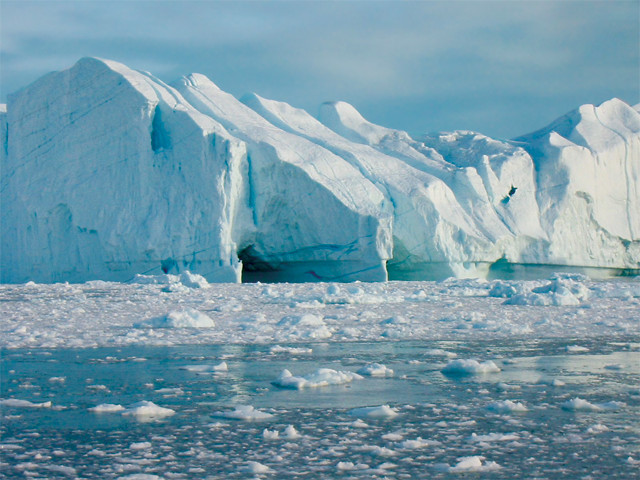
by Mary Caperton Morton Friday, July 17, 2015

A new study suggests that southbound icebergs probably arrived too late to be the trigger for Pleistocene cooling events in the North Atlantic. Credit: ©kaet44, CC BY 2.0.
During the Late Pleistocene, changes in North Atlantic Ocean circulation triggered abrupt changes in global climate: In some locations in the Northern Hemisphere, average temperatures dropped by as much as 10 degrees Celsius within a few decades. Scientists have long thought that freshwater from melting icebergs traveling south from the Arctic may have instigated the circulation shifts that contributed to cooling feedback loops. But now, scientists looking at seafloor sediments collected near Iceland have found that pulses of icebergs typically arrived after the onset of cooling episodes, too late to be primary drivers of climate change.
“Ocean circulation transfers heat from south to north. If you reduce that heat flow, you can make the North Atlantic very cold,” says Stephen Barker, a paleoceanographer at Cardiff University in Wales and lead author of the new study, published in Nature. “One of the ways we can trigger North Atlantic cooling events in climate models is to put freshwater into the system.”
Freshwater slows down ocean circulation by increasing the buoyancy of surface waters, making it difficult for the top layers to sink, which interrupts overall circulation. One potential source of freshwater is icebergs, which are known to have calved from larger glaciers and dispersed south in the Late Pleistocene starting about 125,000 years ago. But some scientists question the exact timing of these dispersions — whether the icebergs were a cause of climate change or merely a consequence.
Evidence of these traveling icebergs is recorded in seafloor sediments in the form of ice-rafted debris — coarse, land-sourced material that is picked up by glacial ice on shore and then dropped into the ocean as an iceberg melts. “This is very coarse material that can’t get out into the open Atlantic from any other source,” Barker says.
To piece together the timeline of cooling events and passing icebergs, Barker and his colleagues turned to a sediment core extracted from a part of the seafloor that was under the path of ice drifting from Iceland, Greenland and Scandinavia. By correlating the appearance of ice-rafted debris, such as quartz grains and volcanic material, in the core with changes in surface-water temperatures recorded in the same core over a period of about 400,000 years, the team showed that, in most cases, cooling preceded the arrival of icebergs by an average of 200 years. Thus, Barker says, “icebergs could not have been the trigger for cooling.”
The new study offers some of the first direct, high-resolution evidence that icebergs were not the primary cause of North Atlantic cooling, says Jorge Alvarez-Solas, a climate scientist at the Complutense University of Madrid in Spain, who was not involved in the new study. “This idea has been challenged for a few years from a modeling perspective,” he says, but modeling “only offers indirect proof. This new study offers some really nice evidence for breaking the iceberg causality theory.”
The work is further strengthened by the researchers' method of using the same sediment core to study the timing between temperature changes and iceberg arrivals, Alvarez-Solas says. “To my knowledge, this has not been done before. When you try to analyze different cores, it’s difficult to interpret the sequence of events, but in the same core, you can be certain of the timing of events.”
Alvarez-Solas says he’s looking forward to seeing how future studies incorporate the new information from the study. “If you no longer can use melting icebergs as a source of freshwater, you’re forced to consider other options for triggering these cooling events,” he says. “It will be challenging to come up with new forcing mechanisms, new ideas, to explain the arrival of iceberg-rafted debris after cooling.”
Barker’s team plans to continue its work by extending the sediment-core records back another 2 million years to reconstruct the nature of abrupt climate change throughout much of the Pleistocene, which could yield clues about the influences of abrupt change on longer timescales.
The work has implications for studying modern climate change as well, in terms of how abrupt shifts in ocean circulation patterns and temperatures are modeled. “We shouldn’t be confident that we will be able to predict when an abrupt change might happen,” he says, because Earth’s climate isn’t a linear system. It can respond in “potentially unpredictable ways.”
© 2008-2021. All rights reserved. Any copying, redistribution or retransmission of any of the contents of this service without the expressed written permission of the American Geosciences Institute is expressly prohibited. Click here for all copyright requests.